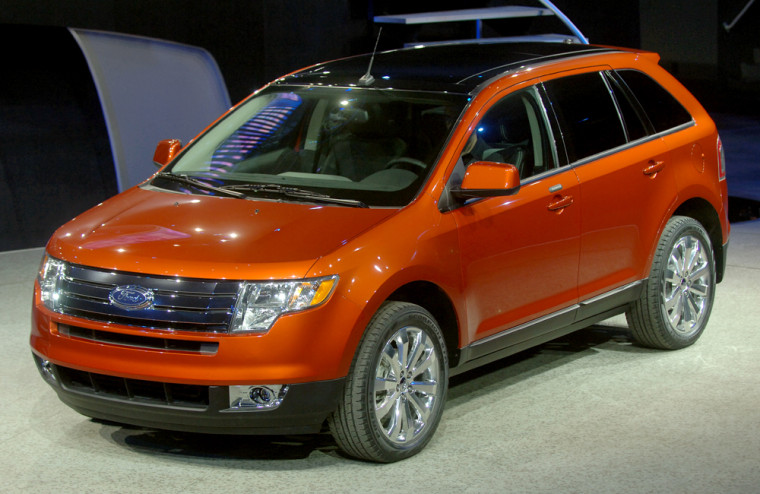When Ford Motor Co. came out with its new Edge crossover in 2006, the company hoped the truck-like vehicle built on a car frame would attract longtime Ford buyers trading in their inefficient sport utility vehicles.
For a while, it worked well. But last month, sales of the Edge and nearly all crossover vehicles dropped dramatically, causing another worry for automakers struggling with the dramatic shift by U.S. auto buyers from trucks to cars.
Automakers and some industry analysts say it's a temporary lull due to a combination of economic worries, sliding SUV values that prevent people from trading them in, and the lingering shock of $4 per gallon gasoline.
But if the trend continues, it's another blow to the profits at Ford, General Motors Corp. and Chrysler LLC, all of which have developed crossovers to capture their traditional SUV and truck buyers.
"The tough part is that's where the U.S. domestics are used to making their money, on people-haulers," said Mark Warnsman, an analyst with Calyon Securities.
The crossover market as a whole peaked this year in March, with all automakers selling 222,055, according to Autodata Corp. Sales dropped in April, rebounded in May and then slid in June to 184,871, down nearly 17 percent from March.
Even the Honda CR-V, a perennial top seller, saw a 21 percent decline in sales from May to June.
George Davis, general manager of Howard Cooper Honda in Ann Arbor, blamed the decline in part on tumbling SUV values and a knee-jerk reaction to high gasoline prices.
"Like everything else, we do overreact," he said. "It's basically sell the SUV, don't even consider another SUV, make sure you get a high gas mileage sedan."
Davis said buyers now are looking for cars that get as close to 40 miles per gallon as possible, shunning even the CR-V, a small crossover that gets up to 20 mpg in the city and 27 on the highway.
Many SUV owners have been stunned when told they would get only $20,000 in trade for a vehicle they paid $35,000 or more for just a short time ago, Davis said.
"They're in a trance. They're paralyzed," he said. "People have never experienced this kind of depreciation because there's just no market for their vehicle."
Midsize SUVs, on average, lost 28.7 percent of their value, from $15,577 in March 2005 to $11,096 at the end of June, according to wholesale auction data from the National Automobile Dealers Association. The figures are adjusted for variations in vehicle mileage.
Many SUV owners who typically would trade for crossovers owe more on their vehicles than they can sell them for, said Aaron Bragman, an auto analyst with the consulting company Global Insight. As a result, they have to keep them and continue buying more gasoline, he said.
"They're typically trading down from larger vehicles, and right now, the resale values of those vehicles are in the toilet," Bragman said.
Generally, truck-based SUVs get in the low teens in city gas mileage and in the upper teens on the highway.
Paul Taylor, the NADA's chief economist, said crossovers, which vary in size but generally get in the high teens in the city and mid-20s in highway gas mileage, are boxier than cars and right now are being shunned to a degree by buyers. Analysts also say buyers associate crossovers with six-cylinder engines when people now are looking for four cylinders.
"They're not even consulting the EPA rating or any other indicator of gas mileage," Taylor said. "They see the big box and see that's not enough mileage to suit me."
Taylor says a glut of used SUVs is fueling a trend toward people parking the big vehicles in the garage and buying small cars for their daily errands. The SUVs come out only when they're needed for hauling or towing, he said.
But Bragman said many buyers, who also have seen their house values decline, are too tapped out to buy anything else.
At the Honda dealership, Davis says his staff advises people in that situation to go for a used small car and keep their SUVs.
"The hit's too big, and they don't want to invest $20,000 or $25,000 in a new car as an additional car," he said.
Many industry analysts expect the crossover slump to continue but end when people eventually trade in the SUVs that are on the road now.
But in the interim, lower-profit small cars are taking up more and more of the market, and that means automakers are making far less profit per vehicle than they make on SUVs or crossovers.
Automakers don't release how much they make per vehicle, but an automaker used to be able to make a profit of $10,000 or more on a high-end SUV, said Jesse Toprak, chief industry analyst for auto information site Edmunds.com.
Auto companies make less on crossovers, although it's not clear how much because they vary so much in size and equipment, he said. And that gap is closing as SUV values continue to plummet, Toprak said.
Many industry analysts worry that the longer the crossover slump lasts, the more cash the troubled Detroit Three will burn as they try to survive the economic downturn. All have lost billions in the past few years as the market has shifted away from trucks to cars.
But George Pipas, Ford's top sales analyst, doesn't see the crossover slump as long-term.
"It's a concern in the sense that it limits the sales potential right here and now," he said. "There are still millions, literally, of Explorers on the road, multimillions of SUVs on the road. Eventually these will get traded."
